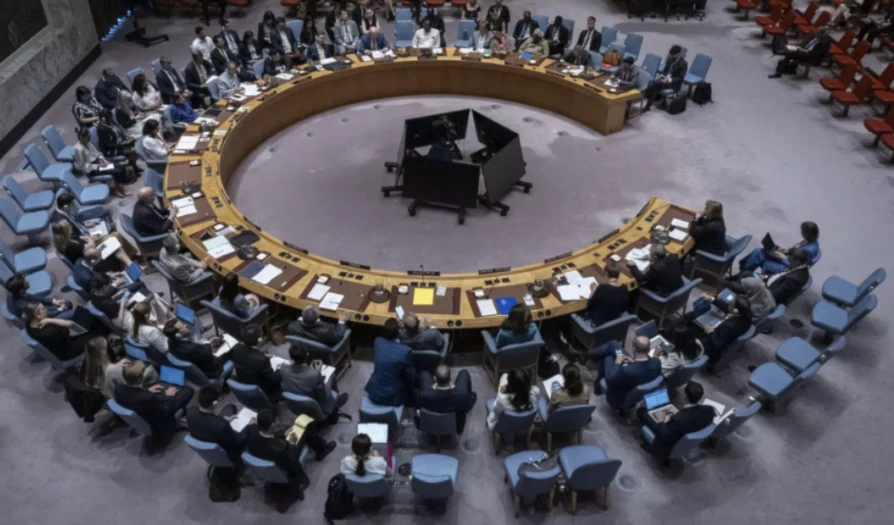'Israel' calculated Gaza’s food needs, then ignored its own math
"Israel" has systematically controlled food access to Gaza through calculated restrictions.
-

Yazan Abu Ful, a 2-year-old malnourished child, sits at his family home in the al-Shati refugee camp in Gaza City, on July 23, 2025 (AP)
"Israel" has long controlled food access to Gaza, using detailed calculations to limit calorie intake for the population, The Guardian reported.
Since 2006, it has enforced what one advisor called a policy to "put the Palestinians on a diet, but not to make them die of hunger."
According to documents released by court order, Israeli authorities determined the minimum food needed to sustain life in Gaza, roughly 2,279 calories per person daily, or 1.8 kg of food. Today, humanitarian groups request even less: about 1 kg of food per person per day.
With Gaza’s own food production halted due to war and blockade, nearly all food must be imported. As famine deepens, Israeli officials deny responsibility, claiming Hamas mismanages aid or that logistical failures are to blame, despite widespread hunger and mounting evidence of calculated restriction.
Famine foreseen, ignored
Between March and June, only 56,000 tonnes of food entered Gaza, less than a quarter of the minimum required to meet the population’s basic needs, according to records from COGAT, the Israeli agency overseeing aid flows.
Even under ideal conditions, if every UN flour delivery had been successfully distributed and the Gaza Humanitarian Foundation (GHF) had implemented safe and efficient systems, there still wouldn’t have been enough food. Hunger was unavoidable.
Now, a “worst-case scenario” famine is unfolding, according to UN-backed food security experts. The Integrated Food Security Phase Classification (IPC) warned this week that food deliveries remain “far below what is needed,” citing “drastic restrictions on the entry of supplies” based on Israeli figures.
The Famine Review Committee, an independent expert panel reviewing IPC assessments, echoed these concerns, concluding that food shipments have been “highly inadequate” and criticizing the GHF’s role in the failing distribution effort.
Crisis framed as logistics, not policy
Gaza faced a complete blockade in March and April, with no food allowed in. Under mounting international pressure over a growing “starvation crisis", Israeli Prime Minister Benjamin Netanyahu announced in mid-May that aid shipments would resume.
Earlier in the year, during a brief January-February ceasefire, a surge of food deliveries had successfully pushed Gaza back from the edge of famine, according to UN data. But when aid resumed in May, it returned only in limited quantities, insufficient to halt starvation, merely slowing its pace.
Now, two months later, widespread suffering has reignited global outrage, and Netanyahu has pledged only “minimal” increases in aid. While the number of food trucks entering Gaza has risen, it remains well below the threshold needed to meet basic nutritional needs, let alone end famine.
Futile airdrops
To supplement ground deliveries, countries including France, Germany, the UK, Egypt, Jordan, and the UAE have resumed airdrops. However, these efforts remain costly, inefficient, and at times dangerous, prompting the MSF to describe this method as “a futile initiative that smacks of cynicism."
“It is not a matter of lacking resources or logistics. The roads are there. The trucks are there. The food and medicine are just a few kilometers away. What’s missing is political will," stated Jean Guy Vataux, MSF’s emergency coordinator in Gaza.
According to Israeli data, just 104 airdrop missions were conducted in the first 21 months of war, delivering the equivalent of only four days’ worth of food for Gaza, at a cost of tens of millions of dollars. That same budget, if spent on truck deliveries, could have brought in far greater quantities of aid. But the true cost of airdrops isn’t just financial.
Reframing Gaza’s hunger crisis as logistical emergency
By resorting to these dramatic, last-resort measures, "Israel" and its allies have reframed Gaza’s hunger crisis as a logistical emergency, rather than the result of deliberate state policy.
Airdrops are typically used when geography or hostile forces make land access impossible. In Gaza, however, the only thing blocking aid from crossing the border by truck is "Israel’s" own restrictions, despite its close ties to Western powers like the US and UK, who continue to supply it with weapons.
Since March, the sharp disparity between Gaza’s nutritional needs and the limited aid allowed in has shown a shift in policy. The numbers no longer aim to prevent famine but rather enable it.

 4 Min Read
4 Min Read










